-

中班数学:比多少课件教案
二、重点和难点 让幼儿利用一一对应的方法发现两个物体集合之间的数量关系。 说明 一一对应是比较物休的集合是否相等的最简便、最直接的方式。通过一一对应,不仅可以比较出两个集合之间量的大小,更重要的是还可以发现相等关系,这是幼儿数概念产生的一个关键性步骤。因此,让幼儿在对材料的操作摆弄中自己“发明”一一对应的方法,并通过一一对应的方法去发现两个物体集合之间多、少和等量关系是至关重要的。 三、材料和环境创设 1.材料:诱发对应性材料--碗和调羹、杯子和杯盖、娃娃和帽子、小兔和青菜、……。自发对应性材料--雪花片和木珠、红积木和绿积木、苹果和香蕉、汽车和飞机等等。以上材料可用实物,也可用图片。 2.环境创设:将以上材料按难易程度编号放暨在数学活动区内供幼儿操作摆弄。
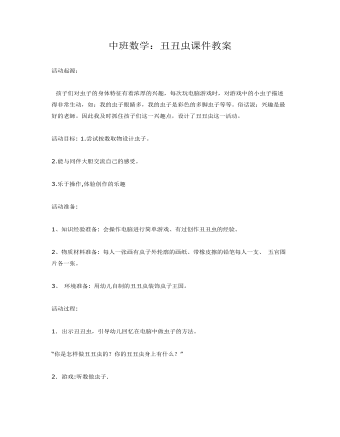
中班数学:丑丑虫课件教案
活动目标: 1.尝试按数取物设计虫子。2.能与同伴大胆交流自己的感受。3.乐于操作,体验创作的乐趣活动准备: 1、知识经验准备: 会操作电脑进行简单游戏、有过创作丑丑虫的经验。2、物质材料准备: 每人一张画有虫子外轮廓的画纸、带橡皮擦的铅笔每人一支、五官图片各一张。3、环境准备: 用幼儿自制的丑丑虫装饰虫子王国。

大班数学:剪“春”课件教案
2、激发幼儿大胆的想象,自由剪出不同变化的“春”字。 3、通过幼儿自主的操作,初步理解“减法”的含义。活动重点:能大胆想象剪出不同变化的“春”字活动难点:初步理解减法的含义材料与环境创设: 1、 幼儿已经学会剪“春”字2、 工具:剪刀、固体胶、手工纸(每人数量不同)方形铅画纸3、 5以内的减法题(人手一份)
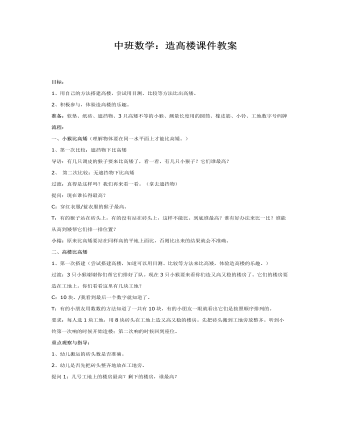
中班数学:造高楼课件教案
2、积极参与,体验造高楼的乐趣。准备:软垫、纸砖、遮挡物、3只高矮不等的小猴、测量长度用的圆筒、橡皮筋、小铃、工地数字号码牌流程:一、小猴比高矮(理解物体要在同一水平面上才能比高矮。) 1、第一次比较:遮挡物下比高矮 导语:有几只调皮的猴子要来比高矮了,看一看,有几只小猴子?它们谁最高? 2、第二次比较:无遮挡物下比高矮 过渡:真得是这样吗?我们再来看一看。(拿去遮挡物) 提问:现在谁长得最高? C:穿红衣服/蓝衣服的猴子最高。 T:有的猴子站在砖头上,有的没有站在砖头上,这样不能比。到底谁最高?谁有好办法来比一比?谁能从高到矮帮它们排一排位置? 小结:原来比高矮要站在同样高的平地上面比,否则比出来的结果就会不准确。

中班数学:编号课件教案
准备 1.每组一套l~5的数字卡片。让幼儿自愿结合,每组5人,要高矮不同。 2.周围环境中有适于幼儿按大小排序的物体。每人一套l~5的数字卡片。 过程 活动(一)小朋友排队编号 1.排队编号。请幼儿从矮到高排队编号。教师交代:每组幼儿从矮到高排队后,报数编号,每人按编号领取相应的数字卡片。幼儿分组排队编号并互相交流,说一说:“自己这队小朋友是怎么排的队?自己排在第几?其他人排在第几?” 2.从高到矮排队编号,方法同上。 3.幼儿讨论。教师提问:“两次排队有什么不同?你都排在第几个?为什么?如:从矮到高排,明明排第1,从高到矮排,明明排第5。明明两次排队位置不同,这是为什么?”
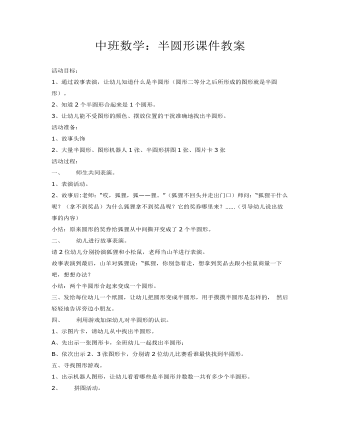
中班数学:半圆形课件教案
2、知道2个半圆形合起来是1个圆形。3、让幼儿能不受图形的颜色、摆放位置的干扰准确地找出半圆形。活动准备:1、故事头饰2、大量半圆形、图形机器人1张、半圆形拼图1张、图片卡3张活动过程:一、 师生共同表演。1、表演活动。2、故事后:老师:“哎,狐狸,狐——狸。”(狐狸不回头并走出门口)师问:“狐狸干什么呢?(拿不到奖品)为什么狐狸拿不到奖品呢?它的奖券哪里来?……(引导幼儿说出故事的内容)小结:原来圆形的奖券给狐狸从中间撕开变成了2个半圆形。二、 幼儿进行故事表演。请2位幼儿分别扮演狐狸和小松鼠,老师当山羊进行表演。故事表演到最后,山羊对狐狸说:“狐狸,你别急着走,想拿到奖品去跟小松鼠商量一下吧,想想办法?小结:两个半圆形合起来变成一个圆形。

中班数学:动物瓶课件教案
2.引导幼儿积极地与材料互动,培养良好的操作习惯。3.让幼儿体验数学活动的乐趣。活动准备:学具:空塑料瓶若干,黄豆若干,1-7不同数量的实物纸条,1-6的数字一组一份。教 具:1-6的数字卡、1-6的加点卡、动物图卡、大瓶子、背景图、头饰(火车头)、磁带。活动过程:1、以开火车游戏激发幼儿活动的兴趣。老师拿点子、数卡、动物图卡和孩子们进行问答游戏。师:嘿嘿,我的火车几点开?(师随机出示6以内的点卡、数卡)幼:嘿嘿,我的火车几点开。师:嘿嘿,来了几位小客人?(出示动物卡片)幼:嘿嘿,来了几位小客人。(反复进行几次)
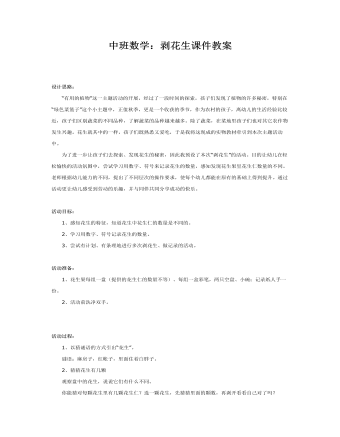
中班数学:剥花生课件教案
为了进一步让孩子们去探索、发现花生的秘密,因此我预设了本次“剥花生”的活动。目的让幼儿在轻松愉快的活动氛围中,尝试学习用数字、符号来记录花生的数量,感知发现花生果里花生仁数量的不同。老师根据幼儿能力的不同,提出了不同层次的操作要求,使每个幼儿都能在原有的基础上得到提升。通过活动更让幼儿感受到劳动的乐趣,并与同伴共同分享成功的快乐。 活动目标:1、感知花生的特征,知道花生中花生仁的数量是不同的。2、学习用数字、符号记录花生的数量。3、尝试有计划、有条理地进行多次剥花生、做记录的活动。
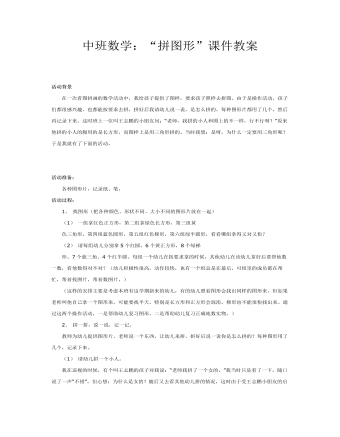
中班数学:“拼图形”课件教案
活动准备: 各种图形片,记录纸、笔。活动过程:1、找图形(把各种颜色、形状不同、大小不同的图形片放在一起) (1)一组拿红色正方形,第二组拿绿色长方形,第三组黄 色三角形,第四组蓝色圆形,第五组红色梯形,第六组绿半圆形,看看哪组拿得又对又快? (2)请每组幼儿分别拿5个红圆,6个黄正方形,8个绿梯 形、7个蓝三角、4个红半圆。每组一个幼儿在按要求拿的时候,其他幼儿在该幼儿拿好后要帮他数一数,看他数得对不对?(幼儿积极性很高,动作较快,也有一个组总是在最后,可组里的成员都在帮忙,帮着找图片,帮着数图片。) (这样的安排主要是考虑本班有这学期新来的幼儿,有的幼儿照着图形会找出同样的图形来,但如果老师叫他自己拿一个图形来,可能要找半天,特别是长方形和正方形会混洧,梯形也不能很快找出来。通过这两个操作活动,一是帮助幼儿复习图形,二是帮助幼儿复习正确地数实物。)
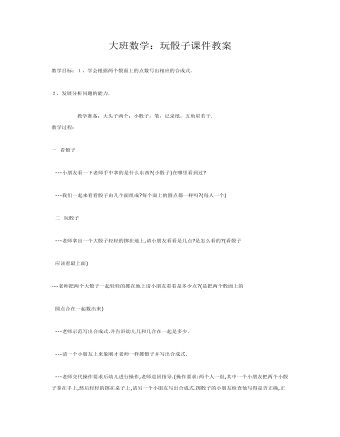
大班数学:玩骰子课件教案
2,发展分析问题的能力. 教学准备:大头子两个;小骰子,笔,记录纸,五角星若干.教学过程:一 看骰子 ---小朋友看一下老师手中拿的是什么东西?(小骰子)在哪里看到过? ---我们一起来看看骰子由几个面组成?每个面上的圆点都一样吗?(每人一个) 二 玩骰子 ---老师拿出一个大骰子轻轻的掷在地上,请小朋友看看是几点?是怎么看的?(看骰子 应该看最上面)-
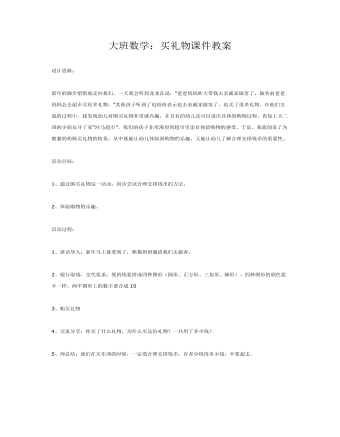
大班数学:买礼物课件教案
活动目标:1、通过购买礼物这一活动,初步尝试合理安排钱币的方法。2、体验购物的乐趣。活动过程:1、谈话导入:新年马上就要到了,熊猫奶奶邀请我们去做客。

人教版新目标初中英语九年级下册I’ll help clean up the city parks教案
Talk about offering help (P60)I’ll help clean up the city parks.A: I’d like to work ...B: You could help ...Talk about ways to tell people about the Clean-Up Day (P61)We need to ...We can’t ...I’ll ...Talk about the work the volunteers do (P62)These three students all volunteer their time to help other people.Somebody loves to ... / helps ... / plans to ... / wants to ...A: What do you like doing?B: I like ... A: What kind of volunteer work do you think I could do?B: You could ...1. 重点词汇advertisement, fix, repair, pleasure, blind, deaf, shut, carry, specially, fetch2. 认读词汇hunger, homeless, cheer, clean-up, sign, establish, major, commitment, elementary, veterinarian, coach, similar, call-in, strategy, disabled, organization, unable, support, appreciate, donation, part of speech, pronoun, adverb, preposition, conjunction, donate, Jimmy, Sally3. 词组clean up, cheer up, give out, put off, set up, think up, take after, fix up, give away, put up, hand out, work out, at once

人教版新目标初中英语七年级下册I ’d like some noodles教案
教学过程Step 1: warming-up Sing a song---------“food and drink” Step 2: Revision1 Dictation2 Revise: What kind of noodles would you like?I’d like …What size bowl of noodles would you like?I’d like…Step 3: Presentation1 show pictures of food, ask students say the words.2 Students read the newspaper ad in 3a. Fill in blanks with words in the box. Then read the ad together, the teacher explains some difficult language points.3 Check the answers Step 4 PracticeAsk students to finish 3b in the same way according to 3a. Students read the short passage and fill in the blanks .At last, check the answers.Step 5 productionAsk students to write their own ad for dumplings, noodles, drinks, and other foods they know. Then ask students to read their partner’s ad. Then order food and drink from their partner.Step 6 Home workGroup work – make an ad about “food and drink”

人教版新目标初中英语七年级下册Where is your pen pal from教案
2.1Match the country with the language.Step II Reading3a? let the students read the letter fast and answer the questions.? Let the students ask more questions about the letter as possible as the can.Step III Writing3b.Step IV. Pairwork2cStep V Listening2a, 2bStep V. HomeworkExercises book(1) P3Exercises book (2) P3Period FourStep I . Dictate the words and sentences in Unit1.Step II. Self-checkStep III. Check the answers for Exercises book in the unit.Step IV. Home workRevise and preparation for unit 2.教学反思:通过本单元的学习,学生基本可以谈论人们的国籍,居住城市及其所说的语言,通过书信方式去介绍自己并寻找笔友。但在涉及到国外的一些城市时,学生对这方面的知识相对欠缺,能介绍的城市并不多,也反应出学生课前预习不充分,这跟学生学习条件也有关,大多数学生无法通过网络获取所需信息。因此,在以后的教学中要多指导学生通过计算机网络获取信息,拓宽知识面。

人教版新目标初中英语七年级下册What do you think of game shows教案
五、教学Section B-2c1. Pair work: What do you think of the belt/sunglasses/…? What does your father/mother/… think of your scarf/belt…?2. Group work(1). Teacher shows some different kinds of school uniforms (制服)and asks : “ What do you think of your school uniforms? If you have a chance to choose your school uniforms, what kind would you like to choose?”(2). Discuss in groups.(3).Get some Ss to report in class.说明:这一步旨在让学生运用已有的语言知识谈论对事物的看法和意见,并简单阐明理由,培养学生的主动思维能力和运用英语的能力。六、教学拓展调查电视节目的收视率任务:调查你周围的人对现在各种电视节目的反响。活动过程:1.教师布置任务,让学生调查周围的人(包括他的亲戚朋友和邻居)喜欢收看哪方面的电视节目。2.学生进行调查活动,运用本单元所学的句型What do you think of….? (Why?)What's your favorite game shows?What do you think of talk show?I doesn’t mind it.I like it.I love it.I can’t stand it.3.记录下排在前10位的TV Program,填写调查表,比较其收视率。

人教版新目标初中英语七年级下册Where did you go on vacation教案
句型: Where did you go on vacation? I went to summer camp.Did she go to Central Park?Yes,she did.No, she didn’t语法:一般过去时特殊疑问句、一般疑问句及肯、否定回答。课时安排4课时第一课时:Section A:la,1b,lc,2a,2b,2c 第二课时:Section A:3a,3b,4第三课时:Section B:1,2a,2b,2c第四课时:Section B:3a,3b,3c,4 and Self Check第一课时教学目标掌握描写假期生活的形容词。假期里自己所做事情的简单表达。谈论假期做的事情及当时情况。谈论假期时旅游的天气,旅游者以及食物等。教学过程一、导入播放一首英文歌曲:Let’s travel 说明:通过让学生听节奏欢快迪斯尼英语歌曲Let’s travel.引入本节课谈论的话题vacation and travel. 让歌曲使学生的思维活跃,增强课堂气氛,激发学生提高学习英语的兴趣。T:How is the trip ?Ss : It’s pretty good/ happy/exciting /relaxing/busy/dangerous/ fantastic说明:这个问题是为了操练形容词。建议让多个Ss作答。鼓励他们用不同的形容词。上述个别形容词本应在第二课时中出现,但可以在warming-up中第一次非正式出现。这些形容词也可在老师的评价语中适时出现,以加深学生对词汇的印象。

人教版新目标初中英语八年级下册Have you ever been to an amusement park教案
(1)Have you ever been to …? Yes, I have. / Yes, I have ever been to …No, I haven’t. / No, I have never been to …(2)When did you go there? I went there last year. (3)I have never been to a water park. Neither have I. I have ever been to an amusement park. So have I. (4)How long have you been studying English? I’ve been studying English since nine o’clock. I’ve been studying English since I came back home. I’ve been studying English for five hours. (5)What’s that? It’s an amusement park in Japan. I’ve never been to an amusement park like it before. It’s fun to learn another language. Let’s go tonight. Isn’t this great?space museum, amusement park, water park, South America, Peru, Holland, European culture, tour guide, flight attendant, musical instrument, more than, be from, get to, take lessons, neither, discover, graduate, change

人教版新目标初中英语八年级下册Why don’t you get her a scarf教案
教师带领学生复习有关描述宠物的词汇,采用教师提问学生回答的方进行。如:T:What animals do you think would be good pets?What animals do you think would be bad pets?What do you think are good animals for a six-year-old child?然后学生进行 pairwork 练习。Task two: 师生互动,学习探究 1、播放3a部分的录音,引导学生一边听录音,一边跟读。2、通过听录音学生回答以下问题:Why do you think pot-bellied pigs are popular?What are the advantages and disadvantages of keeping such a pet?教师对学生的回答进行及时点评。3.学习范文,学习重点短语,为下步的模仿写作提供语言素材。T :1. )Have you ever kept a pig as a pet?Do you like pigs? St.:No.…Why don’t you like to keep a pig? St: No.They’re too dirty and lazy(Do you know in some foreign countries like Hollyland, Australia,pigs are the most popular pet.there’s a kind of pig.(图)it has an interesting name? it ‘s called a pot-bellied pig.) Now,let’s learn an article about this kind of interesting pet.2.)play the tapeSt.:Listen and repeat3.)show some Qs on computer(本子St.: read silently,then answerthe Qs(本子)4.)Ask ss. Close book and retell this passage.(what is a pot-bellied pig? Is it a good or bad pet? ) St.: retell it to each other“A pot –bellied pig is a popular pet now…”5.read the article together.St.:.practice reading

人教版新目标初中英语八年级下册Would you mind turning down the music教案
Step 4. Group work (4)1. Ask a pair of students to read the dialogue. Say, This activity provides speaking, listening and writing practice using the target language.2. Ask students to complete the work in groups.3. Check the answers with the whole class. 4. Explain some of the language points. Step 5. Word review (Self check 1)1. Ask students to read the words and the phrases given. 2. Fill in the blanks with proper forms of these words to complete the sentences. 3. Check the answers with the whole class. Homework:Do activity 2 on page 57 after class. Period 6Teaching aims: 1. Teach vocabulary words and the useful expressions. 2. Enable the students to learn etiquette in different culture. 3. Help the students learn how to behave politely in public places and in daily life. Teaching procedures:Step 1. RevisionHelp students to review the function of making requests through a free talk. Then lead them to the topic of etiquette. Explain the meaning of etiquette. Or, ask students to look it up in the dictionary. Step 2. Pre-reading (Section 1)1. Ask students to read the picture and make a list with their partner about how many rules of etiquette can be seen being broken.

人教版新目标初中英语九年级下册By the time I got outside, the bus had already left教案
Ⅰ. Teaching Aims and Demands1. Knowledge Objects(1) Key Vocabularyoversleep(2) Target LanguageWhat happened?I overslept. And by the time I got up, my brother had already gotten in the shower.2. Ability Objects(1) Teach the students to use the new words.(2) Train the students to narrate past events with the Past Perfect Tense.(3) Train the students' listening and speaking skills with the target language.3. Moral ObjectIt’s a good habit to go to bed early in the evening and get up early in the morning. So you’ll never be in a hurry in the morning.Ⅱ. Teaching Key Points1. Key Vocabularyoversleep2. Target LanguageNarrate past events with the Past Perfect TenseⅢ. Teaching Difficult Points1. Train the students to narrate past events with the Past Perfect Tense.2. Train the students to understand the target language in spoken conversation.Ⅳ. Teaching Methods1. Thinking of examples from the students' real lives.2. Making sentences by looking at the pictures.Ⅴ. Teaching AidA tape recorderⅥ. Teaching ProceduresStep I Revision1. Revise the language points in Unit 8.Ask some questions like this: What volunteer work would you like to do?Help the students to answer, I’d like to…/I love to…/I hope to2. Practice the dialogue in Activity 3c on page 62 again. Get students to role play the similar dialogues with the following.

